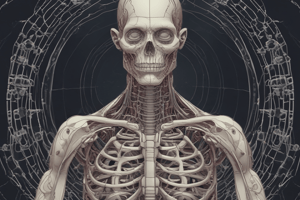Podcast
Questions and Answers
What does the term "anatomy" come from?
What does the term "anatomy" come from?
The Greek words meaning a part (ana) to cut (tomy)
What are the two main types of anatomy?
What are the two main types of anatomy?
- Cellular and Tissue
- Organ and Organ System
- Gross and Microscopic (correct)
- Chemical and Molecular
What is physiology?
What is physiology?
The study of how the body and its parts work or function.
What are the six levels of structural organization in the human body?
What are the six levels of structural organization in the human body?
Which of the following is NOT a function of the integumentary system?
Which of the following is NOT a function of the integumentary system?
Which organ system is responsible for the production of blood cells?
Which organ system is responsible for the production of blood cells?
What is the main function of the nervous system?
What is the main function of the nervous system?
What is the main function of the endocrine system?
What is the main function of the endocrine system?
What is the primary function of the circulatory system?
What is the primary function of the circulatory system?
What is the main role of the lymphatic system?
What is the main role of the lymphatic system?
What is the main function of the respiratory system?
What is the main function of the respiratory system?
Which organ system breaks down food into absorbable units?
Which organ system breaks down food into absorbable units?
What is the main function of the urinary system?
What is the main function of the urinary system?
What is the primary function of the reproductive system?
What is the primary function of the reproductive system?
Flashcards
Anatomy
Anatomy
The study of the structure and shape of the body and its parts, and their relationships.
Physiology
Physiology
The study of how the body and its parts work or function.
Gross anatomy
Gross anatomy
The study of large, easily observable structures, such as the heart or bones.
Microscopic anatomy
Microscopic anatomy
Signup and view all the flashcards
Levels of structural organization
Levels of structural organization
Signup and view all the flashcards
Chemical level
Chemical level
Signup and view all the flashcards
Cellular level
Cellular level
Signup and view all the flashcards
Tissue level
Tissue level
Signup and view all the flashcards
Organ level
Organ level
Signup and view all the flashcards
Organ system
Organ system
Signup and view all the flashcards
Organismal level
Organismal level
Signup and view all the flashcards
Study Notes
Introduction to Human Anatomy
- Human anatomy studies the structure and function of the human body
- Organization of the body progresses from chemical to organismal level
- Covers cell and tissue types, then individual body systems
- Uses resources like "Human Anatomy: The Definitive Visual Guide" and "Atlas and Text-Book of Human Anatomy"
The Human Body: An Orientation
- Anatomy: The study of the body's structure and shape, and how body parts relate
- The word "anatomy" comes from Greek, meaning "a part" and "to cut"
- Gross anatomy: Study of large visible structures
- Microscopic anatomy: Study using microscopes to observe the smallest body parts
Physiology
- Physiology: The study of how body parts function
- Physiology, like anatomy, is subdivided into various fields (e.g., neurophysiology, cardiac physiology) to study different bodily functions
Relationship between Anatomy and Physiology
- Structure influences function.
- Examples include the thin walls of the lungs allowing gas exchange, and the muscular heart pumping blood
Levels of Structural Organization
- 6 levels of organization in the human body
- Chemical level: atoms combine to molecules
- Cellular level: smallest living units
- Tissue level: Groups of similar cells
- Organ level: Structures with specific functions
- Organ system level: Several organs cooperating
- Organismal level: The entire functioning human being
Body Systems
- The human body has 11 systems:
- Integumentary
- Skin, waterproofs, cushions and protects deeper tissues, excretes, regulates temperature and synthesizes vitamin D
- Skeletal
- Bones, cartilage, ligaments, joints, protect and support body organs, framework for muscle movement and store minerals
- Muscular
- Skeletal muscle, contraction and movement, facial expression, posture and produces body heat
- Nervous
- Brain, spinal cord, nerves, and sensory receptors; fast-acting central control system, responses to internal and external stimuli
- Endocrine
- Pituitary, thyroid, parathyroids, adrenals, pancreas, pineal, ovaries, and testes; slow-acting control system, regulates growth, metabolism and reproductions.
- Circulatory
- Heart, blood vessels, capillaries, and blood; carries O2, nutrients, hormones to tissues, and eliminates waste from carbon dioxide
- Lymphatic
- Lymphatic vessels, lymph nodes, spleen and tonsils, complements circulatory system
- Respiratory
- Nasal cavity, pharynx, larynx, trachea, bronchi, lungs; maintains air supply with oxygen and removes CO2 from the body
- Digestive
- Oral cavity, esophagus, stomach, small and large intestines, rectum, anus (liver and pancreas); breaks down food
- Urinary
- Kidneys, ureters, urinary bladder, urethra; eliminates waste and maintains water and electrolyte balance
- Reproductive
- Male: seminal vesicles, prostate, penis, vas deferens, testis, scrotum
- Female: ovaries, mammary glands, uterus, vagina, uterine tubes; primary function of both sexes is to produce offspring
Studying That Suits You
Use AI to generate personalized quizzes and flashcards to suit your learning preferences.
Related Documents
Description
This quiz explores the fundamentals of human anatomy and physiology, focusing on the structure and function of the human body. It covers topics from cell types to body systems, illustrating the close relationship between anatomy and physiology. Ideal for students aiming to understand the organization of the body.



